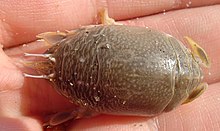Emerita analoga
| Emerita analoga | |
|---|---|
 |
|
| Scientific classification | |
| Kingdom: | Animalia |
| Phylum: | Arthropoda |
| Subphylum: | Crustacea |
| Class: | Malacostraca |
| Order: | Decapoda |
| Infraorder: | Anomura |
| Family: | Hippidae |
| Genus: | Emerita |
| Species: | E. analoga |
| Binomial name | |
|
Emerita analoga Stimpson, 1857 |
|
| Synonyms | |
|
|
Emerita analoga, the Pacific sand crab or Pacific mole crab, is a species of small, sand-burrowing decapod crustacean found living in the sand along the temperate western coasts of America. Also found on the eastern coasts (New Jersey) It is found on exposed sandy beaches in the swash region of the intertidal zone.
The Pacific sand crab is a small crab growing up to 35 mm (1.4 in) long and 25 mm (1.0 in) wide. The female is nearly twice as large as the male and may be identified by the orange egg mass often carried under the telson. The adult is sand-coloured and well camouflaged, and has no claws or spines. It has five pairs of legs and three pairs of pleopods. The crab moults periodically, so its exoskeleton may be found washed up on the beach.
The sand crab is well adapted to life in the sand, which presents an unstable substrate, and its shape is an elongated-dome shape designed for fast burrowing. The eyes are on long stalks and the antennules are also elongated so as to project above the surface of the sand. These form a tube which channels water downwards through the gills. The much longer antennae are retractable. When water is overhead, they also project above the sand surface to collect food particles. The legs and uropods have hairy margins to assist in digging and for use in collecting food and transferring it to the mouth.
The sand crab occurs in North America from Alaska to Baja California and in South America, where it is found from Salaverry, Peru, southwards to around Cape Horn and into southern Argentina. The species is common on the beaches of California, but greater changes in population levels occur further north, probably as a result of variations in the coastal currents which in some years passively disperse the planktonic larval stages northwards. In Oregon, the populations seem not to be self-sustaining and recruitment is largely from larvae originating in California.
...
Wikipedia
